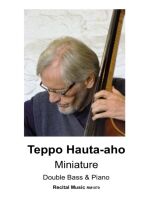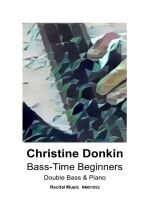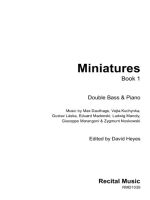Music for 10 Double Basses

Product code:
£12.50
Description
Music for 10 Double Basses
Arranged by David Heyes
- 1. Antonio Lotti – Crucifixus à 10
- 2. Anon. 17th-Century – Sing We Now Merrily (Round)
- 3. Orlando di Lasso – Valle Profonda: Echo
The double bass quartet only dates back to the early 1930s and has subsequently become an established form in our chamber music repertoire, both on the concert platform and for young bassists. Original music for larger ensembles now exists in increasing numbers, including works for 5, 6, 8, 12, 16 and 20 basses, and Recital Music boasts one of the largest catalogues of music for double bass ensembles today.
Alongside original works Recital Music publish a wealth of transcriptions and Music for 10 Double Basses brings together three works arranged by David Heyes. Aimed at the advanced ensemble, each piece offers musical and technical challenges across the entire range of the double bass, with opportunities to experiment with different dynamics and articulations and whether to use vibrato or not.
Antonio Lotti – Crucifixus à 10
This wonderfully accessible and evocative choral work transcribes well for 10 double basses (or cellos) with a range of contrapuntal and antiphonal effects maintaining the interest for performers and audiences alike. Ideal for any youth orchestra bass section or conservatoire bass department, there are challenges here for ensemble study and also great opportunities to create a unique performance by adding your own dynamic contrasts.
Antonio Lotti was born in Venice of Hanover in c.1667 and died in Venice in 1740. He became organist at St. Mark’s (Venice) in 1690, eventually becoming maestro di cappella in 1736, and was a prolific composer of operas and church music. Much of his vocal music has remained popular until the present day, particularly his settings of Crucifixus for 8 and 10 voices.
Lotti’s music bridges the late Baroque and early Classical styles and Charles Burney, who heard his church music in 1770, characterises his music as both solemn and touching, and capable of expression through his effective and masterly use of counterpoint.
Anon. 17th-Century – Sing We Now Merrily (Round)
First printed in 1609, the round is for 10 equal voices and this new edition includes versions in three keys – G, D and C major. A range of dynamics and articulations can be added to create interest and contrast and rounds are useful for both concert and educational use.
Orlando di Lasso – Valle Profonda: Echo
Valle Profonda: Echo (Deep Valley: Echo) was first published in 1584 and is scored for two vocal quintets, with the second quintet acting as an echo. The music is generally slow moving, exploiting the sonorous and cantabile qualities of the double bass, and dynamics can be added at the discretion of the conductor or ensemble.
The antiphonal possibilities create exquisite harmonies and effects, alongside both a rhythmic unity and conflict, with the two quintets only meeting on the final chord of the final bar of the piece.
Orlando di Lasso was born in Belgium in 1532 and died in Germany in 1594 and stands alongside Palestrina and Victoria as the leading composers of the late Renaissance. He was enormously prolific, writing more than 2,000 sacred and secular vocal and choral works, but no instrumental music has survived.
Description
Music for 10 Double Basses
Arranged by David Heyes
- 1. Antonio Lotti – Crucifixus à 10
- 2. Anon. 17th-Century – Sing We Now Merrily (Round)
- 3. Orlando di Lasso – Valle Profonda: Echo
The double bass quartet only dates back to the early 1930s and has subsequently become an established form in our chamber music repertoire, both on the concert platform and for young bassists. Original music for larger ensembles now exists in increasing numbers, including works for 5, 6, 8, 12, 16 and 20 basses, and Recital Music boasts one of the largest catalogues of music for double bass ensembles today.
Alongside original works Recital Music publish a wealth of transcriptions and Music for 10 Double Basses brings together three works arranged by David Heyes. Aimed at the advanced ensemble, each piece offers musical and technical challenges across the entire range of the double bass, with opportunities to experiment with different dynamics and articulations and whether to use vibrato or not.
Antonio Lotti – Crucifixus à 10
This wonderfully accessible and evocative choral work transcribes well for 10 double basses (or cellos) with a range of contrapuntal and antiphonal effects maintaining the interest for performers and audiences alike. Ideal for any youth orchestra bass section or conservatoire bass department, there are challenges here for ensemble study and also great opportunities to create a unique performance by adding your own dynamic contrasts.
Antonio Lotti was born in Venice of Hanover in c.1667 and died in Venice in 1740. He became organist at St. Mark’s (Venice) in 1690, eventually becoming maestro di cappella in 1736, and was a prolific composer of operas and church music. Much of his vocal music has remained popular until the present day, particularly his settings of Crucifixus for 8 and 10 voices.
Lotti’s music bridges the late Baroque and early Classical styles and Charles Burney, who heard his church music in 1770, characterises his music as both solemn and touching, and capable of expression through his effective and masterly use of counterpoint.
Anon. 17th-Century – Sing We Now Merrily (Round)
First printed in 1609, the round is for 10 equal voices and this new edition includes versions in three keys – G, D and C major. A range of dynamics and articulations can be added to create interest and contrast and rounds are useful for both concert and educational use.
Orlando di Lasso – Valle Profonda: Echo
Valle Profonda: Echo (Deep Valley: Echo) was first published in 1584 and is scored for two vocal quintets, with the second quintet acting as an echo. The music is generally slow moving, exploiting the sonorous and cantabile qualities of the double bass, and dynamics can be added at the discretion of the conductor or ensemble.
The antiphonal possibilities create exquisite harmonies and effects, alongside both a rhythmic unity and conflict, with the two quintets only meeting on the final chord of the final bar of the piece.
Orlando di Lasso was born in Belgium in 1532 and died in Germany in 1594 and stands alongside Palestrina and Victoria as the leading composers of the late Renaissance. He was enormously prolific, writing more than 2,000 sacred and secular vocal and choral works, but no instrumental music has survived.



